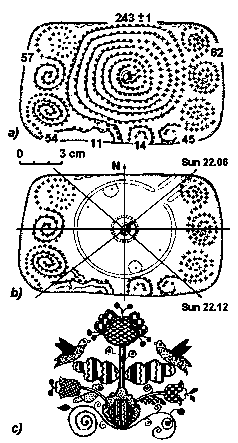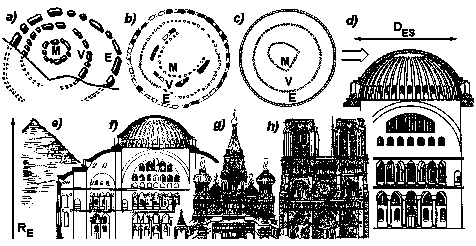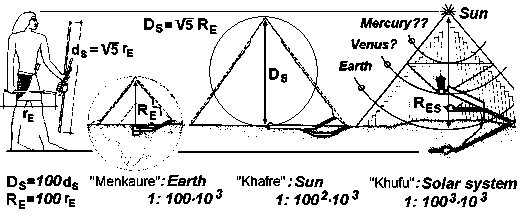Alexander Anoprienko
- Introduction
- “Life / world tree”: the earliest known simulation tool?
- Megaliths as “models of the world”
- Conclusions
- References
ABSTRACT
The main idea of
this paper is a hypothesis that the simulation play an essentially more
significant role in a human history and culture than it is usually assumed.
On some examples it can be demonstrated that modern computational simulation
has ancient prototypes and some artefacts can be interpreted as special
simulation tools and environments. As typical examples of ancient simulation
tools the “life/world tree” on mammoth bone and megalithical “models of
the world” are presented. These artefacts were interpreted earlier as calendars,
observatories or “ancient computers”. The proposed hypothesis considers
the following interpretation as most exact and appropriate: “special computational
simulation tools and environments with real-time functions (calendar) and
real-world interface (observatory)”.
The history of modern study of archaeosimulation begins from researches of Gerald S. Hawkins on Stonehenge more than 30 years ago (Hawkins and White 1966). Hawkins was not only the first who used a modern computer for the analysis of the ancient construction, but also he has declared the existence of "stone computers". Late other megalithic monuments were investigated and described, which were probably used as observatories and special original computers for registration and forecasting of the astronomical events (see, for example, Wood 1978). Almost all described structures can be interpreted as simulation tools.
As well as for modern science for ancient people the various forms of computational simulation were the most powerful means of research and understanding of complex dynamic processes of the real world. New results described in the given work permit to interpret some other well known ancient artifacts as special tools for simulation.
“Life / world tree”: the earliest known simulation tool?
 In
the Hermitage in St. Petersburg a small plate of mammoth bone with spiral
figures of many dozens of dots is stored (Fig. 1a). It was found in 1929
in village Malta near the western part of the Baikal lake (Siberia). The
age of the plate is more than 15 thousand years.
In
the Hermitage in St. Petersburg a small plate of mammoth bone with spiral
figures of many dozens of dots is stored (Fig. 1a). It was found in 1929
in village Malta near the western part of the Baikal lake (Siberia). The
age of the plate is more than 15 thousand years.
While stored in the Hermitage the plate was periodically investigated
by various scientists. One of the first was a German mythologist Karl Hentze.
Hentze interprets spirals of the plate as symbols of the moon phases and
even as an image of the whole universe, but without any quantitative analysis.
The most careful analysis of semantics and quantitative system of the plate
was done more than 10 years ago by Russian professor Larichev (Larichev
1989). His conclusions were as follows: advanced knowledge about the visible
movements of the star sky are fixed on the plate, which are a result of
exact long-term observation of the Sun, Moon and visible planets. The precision
of registration and representation of the information is quite enough for
a sure prediction of the lunar and solar eclipse!
Larichev has detected the following main elements on the plate:
- solar year: 243+62+45+14 = 365 days;
- lunar year: 243+57+54 = 354 days;
- four-year cycle: (242+63+45+14+11+54+58)x3 = 365.24 x 4 = 1461 days;
- sidereal form of the saros: 242x27,21=6585.35 days =18.61 solar years = 19 sidereal years;
- synodic form of the saros: (54+57+63+45+4)x29.53 = 6585.35 days;
- synodic cycle times for planets:
1) The Malta plate model permits besides an exact “scientific” simulation of motions on the sky sphere also a simplified pragmatic “calendar” simulation for wide use:
- » 1/6 of the solar year: 62 days;
- » 1/8 of the solar year: 45 days;
- » double sidereal month: 54 days;
- » double sinodic month: 58 days;
- » synodic cycle time for Mercury (four internal points of an element “14”): 4 x 29.5 = 116 days;
- » synodic cycle time for Venus (ten external points of an element “14”): 10 x 29.5 x 2 = 590 days.
2) The element "14" can be easily used for observation of the female reproductive cycle:
Stage 1: 10 “external” days of barren period followed by menstruation.
Stage 2: (4+4) “internal” days followed by ovulation.
Stage 3: 10 “external” days before menstruation.
Stage 4: If menstruation does not come in time, then it will
be necessary to make testy pass of the whole cycle (10+4+4+10).
Stage 5: In case of delay of the menstruation the cycle must
be corrected.
Stage 6: If during the test pass of the cycle the menstruation
was not, then go to central spiral “242”.
General term of pregnancy is 10+28+242=280 days.
Then central part of the plate can be interpreted as the “life tree”.
3) “Malta plate” was probably wide used special computational tool in ancient society, and it can be interpreted as specific simulational prototype for the famous mythological concept of “life/world tree” (Fig. 1c).
4) Baikal is located on the same latitude as Stonehenge. Main solar and lunar directions for Stonehenge and for the “mammoth plate” coincide. The plate could be used also as a "personal Stonehenge" or microobservatory (Fig. 1b).
5) Such form of fixing and transfer of the information allowed at the initial stage of history of the civilization (more than 10 000 years ago) to accumulate, apply and transmit knowledge without alphabet and another forms of writing.
Megaliths as “models of the world”
It is possible to assume, that a long history of accumulation and application of knowledge in the form of special computational models allowed to define real parameters of the Earth and solar system. By creation of various models and their verification long before beginnings of the Greek antique science such parameters, as the sizes of the Earth, Moon and Sun, as well as distance between them and visible planets could be determined.
Now there is a possibility to prove, that some of the today known megaliths were special simulation tools or environments. The most famous is Stonehenge, but there are some other such examples (Fig. 2). Windmill Hill (3100 BC) and Durrington Walls in England, Cairnpapple (2000 BC) in Scotland and others (Mü ller-Karpe H. 1966; Hawkes J. Ed. 1974; Burl A. 1995; Ruggles C. 1996) can be interpreted as scaled models (1:109 or 1:1010) of solar system with the Earth, Venus and Mercury orbits.

Figure 2. Megaliths and churches: a) Windmill Hill (300 m in diameter); b) Stonehenge-II (30 m in diameter); c) The Sarmizegethusa circular shrine; d) Hagia Sophia (Istambul); e) Mycerinus (Menkaure) pyramid; f) Hagia Sophia (Istambul); g) Basileus Cathedral (Moscow); h) Notre Dame Cathedral (Paris)
A good example of computational simulation environment is circular shrine (30 m in diameter) in Sarmizegethusa (southern Rumania). Sarmizegethusa was Dacian capital in about 100 BC until its destruction by the Romans in AD 106. The circular shrine (Fig. 2c) consists of an outer ring of andesite blocks with a ring of small andesite pillars immediately inside. This inner ring is composed of runs of six taller and more slender pillars separated by one that is shorter and thicker. There are 30 of these runs of six, and it seems that total of 180 stand for one half of the Dacian year. This circle E can simulate the orbit motion of the Earth with two days interval between dots. The rings V and M can simulates orbit motions of Venus and Mercury respectively (with three days interval between dots).
As well as others examples, the three great ancient pyramids of Egypt can be interpreted as special simulation environments (Fig. 3).

Figure 3. The three great ancient pyramids of Egypt can be interpreted as scaled "model of universe"
We have now a large collection of hypothesizes about pyramids, the majority of which are unacceptable for the modern science and society (Jenemann 1996). Considering pyramids as a scaled “model of universe” permits to explain many: why they were built at all and why they were built just so.
On the basis of the analysis of the initial period of ancient Egypt in context of archeosimulation the following hypothesis can be formulated:
1) In ancient civilization, as well as now, the leading role in the development of society exact knowledge and means for their production and distributions played. Myths and symbols appeared in popularization process of intelligent achievements in the field of exact sciences. As such characteristic example can serve also the pyramids.
2) A key word for understanding of the great pyramids is "parallax". The correct understanding of the great pyramids is possible only in interrelation with a system of ancient measures, which were also a specific “model of universe”. The main items of information on the sizes of the solar system during construction of the pyramids were already known (considerably more precisely, as it is attributed to antique science), and one of the purposes of this system was current check and refinement of these parameters. It was impossible without exact knowledge about daily and year parallax, which were reliably fixed in the proportions of the pyramids (Fig. 3): RE - scaled earthly radius (one half of the daily parallax), DS - scaled solar diameter, RES - scaled distance from Earth to Sun (one half of the DES - scaled year parallax: DES=1.08 DS). It is necessary to note, that factors 1.08 and Ö 5 acquired in ancient world a sacral significance.
The items of the information received as a result of their use were practically unknown to majority of mankind, but their vestiges can be found in all subsequent culture. It is possible to note, in particular, their influence to architecture and main sizes the of the most known churches (Fig. 2f, g, h).
Conclusions
- Described artifacts can be used as a good indicators of the real intellectual development of the mankind.
- The history of computational simulation can be lengthened to more than 15 thousands years.
- Exact knowledge and tools for the quantitative simulation and knowledge distribution played in the ancient civilisation, as well as now, the leading role in the development of society. Most of myths and symbols, for example, were created in the popularisation process of the achievements from the field of exact sciences.
- It is possible to generalise, that the computational simulation was used as one of the major tools for intellectual and cultural development of mankind during all history of the civilisation.
References
- Burl A. 1995. A guide to the stone circles of Britain, Ireland and Brittany. Yale University.
- Calvin W. 1991. How the Shaman Stole Moon. In search of ancient prophet. Bantam books, n.y., http://weber.u.washington.edu/~wcalvin/bk6.html
- Hawkes J. Ed. 1974. Atlas of Ancient Archaelogy. Heinemann, London.
- Hawkins G. S. and White J.B. 1966. Stonehenge Decoded. Dell, London.
- Jenemann H. R. 1996. Ueber die Zahlenmystik an der Grossen Pyramide zu Giseh. Intern. Zs. F. Gesch. U. Ethik der Naturwiss., Technik u. Med., no. 4: 249-268.
- Larichev, V. E. 1989. Wisdom of the Snake: Ancient Man, Moon and Sun. Science, Novosibirsk (Russian language).
- Mueller-Karpe H. 1966. Handbuch der Vorgeschichte C.H.Beck’sche Verlagsbuchhandlung, Muenchen.
- Ruggles C. 1996, Archaeoastronomy. The study of astronomical practice in past societies. leicester univ. http://indigo.stile.le.ac.uk/~rug/aa/gen/r1.html
- Wood J. E. 1978. Sun, Moon and Standing Stones. Oxford University Press.
Anoprienko A. Interpretation of some artefacts as special simulation tools and environments // Short Papers Proceedings of the 1997 European Simulation Multiconference ESM'97. Istanbul, June 1-4, 1997. - Istanbul: SCS. - 1997. - P. 23-26.